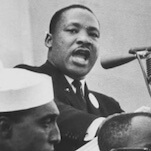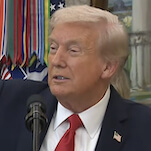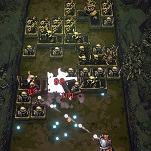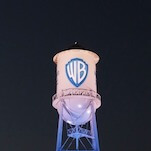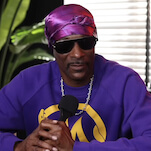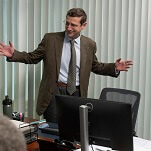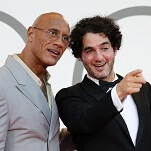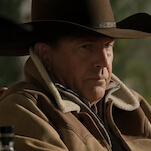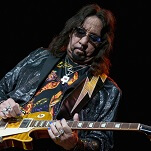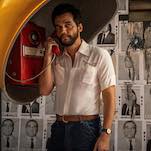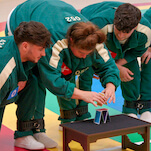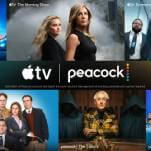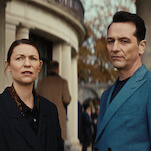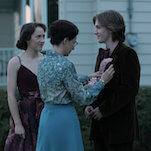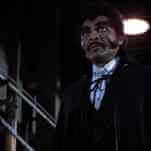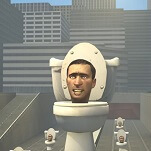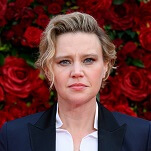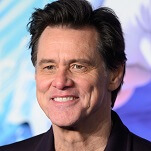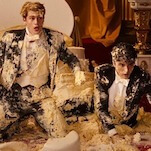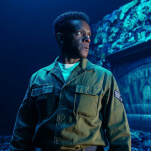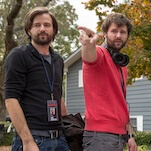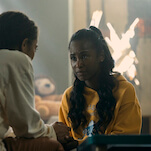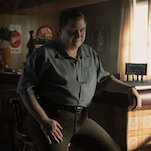There’s no doubt The Maya Rudolph Show showcases the former Saturday Night Live star’s many talents, giving her a chance to soak up the spotlight as she sings, dances, and jokes her way into our hearts… or at least through a harmless hour-long variety show with her buddies.
Those talents are prodigious. Maya Rudolph sings with a pop star’s power, a soul singer’s range, and a comedian’s control, able to wring passion and laughter from consecutive verses with commanding ease. Better still, she knows when to belt it out and when to hold back. In a lullaby that guest Chris Parnell has written about his newborn baby, Rudolph reins in her impressive pipes to allow Parnell’s modest, pleasant voice to shine as they sing the simple truth: Only a baby can inspire ardent affection while despoiling a whole home with urine and vomit. The simplicity of this performance—no elaborate set, no glitter, no gags—lets it stand out in quiet clarity as the most heartfelt, warmly funny piece of the night.
Other small moments play out with similar effectiveness, highlighting Rudolph’s delicate mastery of timing and physicality. Her practiced, seemingly effortless proficiency shows in the smallest gestures and tones: the subtly swallowed “l” of “Indianapolis” as uttered by Mrs. Garmyn, the familiar voice of GPS systems; the infinitesimal dance moves with which Maya bests guest Andy Samberg’s dance-off challenge when she dares to “go small,” just like her soon-to-perish grandma taught her.
If The Maya Rudolph Show had dared to go small more often, to trust in the long-honed prowess of its host, or to go as big with the comedy as it did with its splashy musical numbers, it might have been a greater success. Instead, the show presents an amiable but not especially interesting or entertaining piece of television, a curio rather than the renaissance of a format.
As Dennis Perkins so aptly observed of this season’s Saturday Night Live finale, this first (and possibly only) outing of The Maya Rudolph Show relies more on the audience’s affection for the performers and a nostalgic embrace of their antics than on carefully crafted comic writing. The variety show meanders from musical number to sketch to musical number with no notable vigor or zest, which is particularly dispiriting since Rudolph has always been a performer of great vitality and specificity, investing her many characters and roles with both humanity and hilarity.
It would be easy to blame the format for this laxity. Variety shows, popular since the earliest days of television, dropped out of favor in the U.S. in the ’70s when they became a playground for our most famous stars to trot out lazy, borderline-risqué jokes and popular songs watered down to make them palatable for the broadest possible audience. A complex chain of factors pushed the variety show to the excesses for which it’s now remembered. From the 1950s to the 1970s, variety shows, with their mix of song, dance, and light comedy sketches, catered to an always-growing audience watching a still-small number of channels, providing light fare suitable for all audiences. A little music, a handful of skits, maybe some dancing: It all added up to a pleasant enough mixture likely to divert, if not delight, the whole family.
More than that, variety shows gave viewers a glimpse of famous actors and familiar faces speaking not in roles but as themselves, and gave stars a chance to break free from their personas—or a chance for stars constrained by long-running characters and shows to play on that familiarity with a knowing wink. Seeing Lee Majors softshoe his way through “Puttin’ on the Ritz” or a masked Leonard Nimoy ride in on a hobby horse as The Lone Plumber humanized the actors and leavened the sometimes stiff impressions endowed by their iconic roles.
In today’s media-saturated landscape, TV and movie stars don’t have the same mystique they once did, and watching them perform goofy skits or silly songs doesn’t offer the frisson of mild mischief that became the old-fashioned variety show’s most potent ammunition. That’s doubly true when the show in question relies not on a stable of charismatic or distant actors, but on a clutch of Maya Rudolph’s SNL alumni (and, oh yeah, Sean Hayes). The Captain & Tennille or Donny & Marie could squeeze some rascally fun out of the sheer silliness of an Andy Griffith or a Farrah Fawcett vamping their way through indifferent skits, but when the troupe includes seasoned comedians and sketch players, the bar is set higher.
That’s not to say that there’s no hope for the variety show in general, or for The Maya Rudolph Show specifically. At its heart, the variety show is just a vaudeville stage show or a music hall revue packaged up in an hour-long program and broadcast into your home. Like any good revue, it should be shaped by the tastes and tempos of its era, and more importantly, it should be built around the talents of its star.
The Maya Rudolph Show veers between a glittery, lavish explosion of song and frothy dresses, a genre-wise parody of The Lawrence Welk Show, and a collection of unpolished SNL sketches. If NBC decides to extend this one-off production into a summer replacement series, the writers will need to decide what the show is and embrace that as lustily as Maya Rudolph embraces her many characters (and many, many dresses).
To be more than a lavish curiosity, an artifact of a bygone era reconstructed for our tolerant amusement, The Maya Rudolph Show needs to assess its strengths. And its greatest strength is right there in the title: Maya Rudolph.
Stray observations:
- Maya’s dance with The Laker Girls harkens back not only to the traditional variety-show reliance on dancing girls, but perhaps specifically Donny & Marie’s opening scene featuring ice skaters.
- “I wanna jam out with my clam out, is that a phrase?”
- Maya’s dresses are worthy of Eydie Gormé and the Mandrell Sisters.
- “Voluminous whhhhigs.”
- During Janelle Monáe’s performance, the camera largely frames her from the waist up, ignoring her nimble feet as she slides and skates across the stage, reducing and confining her characteristic fluid and energetic stage show, though she beams out joy and verve as always.
- It has to feel good to be name-checked by Janelle Monáe as “the #1 Electric Lady, Maya Rudolph!” and even better when it’s followed up with the lyric “Tonight we’re going to do what we want to do.”

